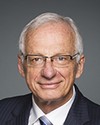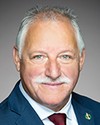Good afternoon, Mr. Chairman and members of the committee, ladies and gentlemen.
I want to thank you for your invitation today to offer insight regarding services for military and veteran families in transition.
As the director general of Morale and Welfare Services, I am also the managing director of Non-Public Property and the chief executive officer of the Staff of the Non-Public Funds of the Canadian Forces.
I'm very pleased to have this opportunity to talk about our military family services division, whose mandate is to ensure the Canadian military family community is well supported and that military families specifically are able to lead positive, nurturing lives comparable to other Canadian families.
Joining me today is Colonel Dan Harris, the director of military family services.
The military family services division is composed of regular force; reserve force; civilian, non-public fund staff; and public servants. This division oversees three major programs that serve to address the unique aspects of a military lifestyle. As the military family services program is a publicly funded program, it's delivered through a non-public property framework, and it includes funding to third-party, non-profit organizations, known as military family resource centres. We also have the children's education management program, a publicly funded program that manages education with compensation and benefits to military members and dependent children. This program includes the recent addition of a guidance counselling component, delivered by non-public funds staff, which has proven highly beneficial to military families as they move and transition.
The veteran family program is a program funded by Veterans Affairs Canada. It's executed by Canadian Forces morale and welfare services through a memorandum of agreement. This program extends the military family services program to all medically releasing members and released members and their families.
The military family services program is available to families via three access points so that families can access the services they require in a manner that best suits their needs. First, families can visit one of 32 non-profit military family resource centres located on bases and wings across Canada. We also staff military family services points across the United States and Europe so that families who are posted outside of Canada, known as OUTCAN, can receive the same level of support services. The staff who work OUTCAN are employees of the non-public funds, unlike the staff at the military family resource centres in Canada who have a voluntary board of directors as their own employer of record.
Secondly, families can access our services through our 24-7 family information line. This service provides bilingual, confidential, and referral information services to families by trained counsellors who know how to navigate the often complicated life of the Canadian Armed Forces federal, provincial, and municipal policy infrastructure. We've also recently extended this service to now include scheduled phone or video sessions to make it easier for families to connect with our counsellors.
The third access point to the military family services program is through a central online source of information for military families at a website called CAFconnection.ca. This is a mobile-friendly web portal that allows families to access all of the military family resource centres as well as national information and resources relevant to all military families. This would include veteran families in the transition program.
The Canadian Armed Forces ombudsman's report, “On the Homefront”, which was released in 2013, was an important report that identified three aspects specific to our military lifestyle: the constant geographic relocation, the extensive absences from loved ones, and the risk inherent in the profession of arms. It is these three characteristics that set our serving members and their families apart from civilian families and define their needs for supports and services.
The government's new “Strong, Secure, Engaged” defence policy recognizes the important sacrifices made by families in their role as a major source of strength and support to serving members. As part of “Strong, Secure, Engaged”, and in the first phase of increased support to military families, $6 million per year in new funding has been authorized to modernize the military family services program and provide additional support to military families, allocated to the military family resource centres and the military family services.
“ Strong, Secure, Engaged” also directs a second phase of support through development of a comprehensive military family plan to augment support services and to stabilize family life for Canadian Armed Forces members and their families. The development of the comprehensive military family plan also falls within Canadian Forces morale and welfare services' responsibility on behalf of chief military personnel. Challenges such as establishing relocation expertise and engaging federal, provincial, and private sector partners to improve the coordination of services across the provinces are some of the issues we'll be tackling in this plan.
In the context of today's appearance, I'd like to touch specifically on the realities of a medically releasing member, their transition, and what it means in terms of family support, the challenges faced by those families, and how the military family services program is responding. Releasing from the Canadian Armed Forces can be challenging and emotional, and becomes even more so when it's the result of a medical condition, where a medical release is concerned.
When a serving member leaves the Canadian Armed Forces, their family does as well. The entire family is a step away from their extended family and support structure, the Canadian Armed Forces and our service. The serving member and their family have to consider how to find those services in the areas of health care, employment, and education, and navigate in areas that are unfamiliar to them.
This is why the veteran family program, which began as a pilot program in November 2015 at seven family resource centre sites, was initiated for medically releasing members. As of April 1, 2018, all medically releasing members of the Canadian Armed Forces and their respective families will be eligible to access the veteran family program through all access points, such as the MFRCs, the family information line, and CAFconnection.ca. There is no specific end date to their eligibility. The focus is to support their transition to civilian services and programs.
The veteran family program is intended to ease the transition for the entire family and provide familiarity within a framework of services that are already well known by the military family. It's meant to provide a seamless transition of support and services at a time when medically releasing members and their families are struggling the most.
Our Veterans Affairs, military family services, and military family resource centre teams have been working closely together since the budget announcement of March 2017 to operationalize the nationalization of this program and ensure a seamless transition for all. Military family resource centres have hired veteran family coordinators, and joint training for new coordinators and VAC service case managers is taking place and will be completed at the end of February to ensure an alignment of information and services.
The move to nationalize the veteran family program is a testament to the efforts of seven pilot centres and the working groups who work diligently behind the scenes to lay a solid foundation. For your information, the seven pilot centres were in Esquimalt, Edmonton, Shilo, North Bay, Trenton, Valcartier, and Halifax. They have been consulted extensively, and have imparted their insights and learnings from the initial two-year period.
During this pilot period, from October 2015 to October 2017, there were over 11,000 interactions with medically releasing members, spouses, and family members at the pilot sites. Additionally, there were over 1,200 family information line interactions with releasing members, spouses, and family members, and another 15,500 unique page views on our CAFconnection website.
We at Morale and Welfare Services and Military Family Services are eager to launch the new Veteran Family Program, along with our MFRC and community service partners and to continue making a real difference in a lives of members, veterans and their families.
Thank you again for the opportunity to appear before you today.
Mr. Chairman, I would be pleased to respond to the committee's questions.










